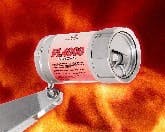With a next-generation multi-spectral infrared flame sensor that incorporates neural network technology (NNT), the new FL4000 Intelligent Multi-Spectral IR (MSIR) Flame Detection System from General Monitors sets a new industry standard for performance, reliability and value. The FL4000 gives process and plant engineers a potent new tool in protecting people, equipment and facilities from dangerous hydrocarbon flame sources.
Until now, flame detection has been based on multi-spectral optical flame detectors integrated with expert signal processing. This type of system relies on an expert to design a fixed set of conditions. While these devices meet basic flame detection needs, they are prone to false alarms caused by reflected sunlight, arc welding, hot piping, machinery, and other false alarm sources.
The new FL4000 combines an advanced optical MSIR sensor array with NNT processing. NNT is based on artificial neural networks (ANN), which are mathematical models of biological neurons in the human brain that correlate given signal patterns with target flame conditions. The optical IR sensor array and the neural network function together as an adaptive and intuitive decision-making mechanism with boundless optimization capability. The result is a breakthrough flame detector that provides the industry’s most reliable discrimination between actual flames and nuisance false alarm sources.
The FL4000’s MSIR detector makes use of four separate infrared spectrums sampling different IR spectral areas to detect a flame. Each sensor’s analog signals is sampled and then converted into digital format for initial signal pre-processing to extract time and frequency information. The time and frequency information are used by the FL4000’s proprietary neural network classification algorithm to identify if input IR signals are emitted from a flame or non-flame source. The flame or non-flame decision is then reported as an output via LEDs, relays, and MODBUS.
With its highly reliable NNT flame discrimination algorithm, the FL4000 detector is highly immune to false alarms while at the same time offering extended range (up to 230 feet) and field-of-view (FOV) characteristics (100° at 50 ft.). For example, the new FL4000 MSIR flame detector provides false alarm immunity to arc welding as close as 10 feet away. Other features include built-in COPM (Continuous Optical Path Monitoring) self-diagnostic circuitry checks the optical path integrity and the detector’s electronic circuitry once every two minutes. Serial ports allow up to 128 units (247 using repeaters) to be linked up to a host computer using the MODBUS RTU protocol.
The FL4000 sets a new benchmark for performance, reliability, safety and value in flame detection. Accurately and reliably detecting flames has long been a technical challenge in the oil/gas, petrochemical and many other industries. The ability to differentiate spectral radiation emitted by actual flames from that emitted by background ambient radiation is absolutely crucial. Failure to do so results in either undetected fires or more commonly, nuisance false alarms that interrupt operations, trigger suppression equipment, consume extinguishing materials, require resolution of the alarm condition and often operational or plant re-starts. The FL4000 is the next-generation solution in flame detection.




